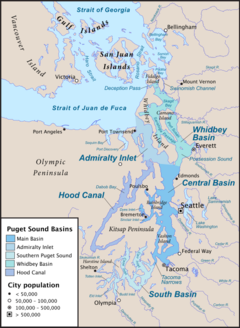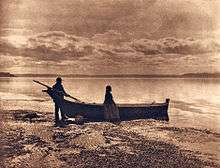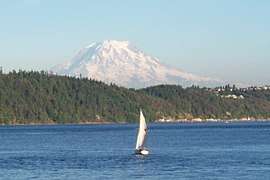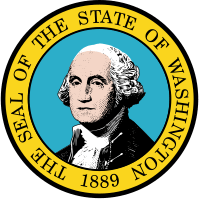Puget Sound region
The Puget Sound region is a coastal area of the Pacific Northwest in the U.S. state of Washington, including Puget Sound, the Puget Sound lowlands, and the surrounding region roughly west of the Cascade Range and east of the Olympic Mountains. It is characterized by a complex array of saltwater bays, islands, and peninsulas carved out by prehistoric glaciers.

Poet Robert Sund called the Puget Sound region "Ish River country", owing to its numerous rivers with names ending in "ish", such as the Duwamish, Samish, Sammamish, Skokomish, Skykomish, Snohomish, and the Stillaguamish.[1] The ish ending is from Salishan languages and means "people of".[2]
History

The Puget Sound region was formed by the collision and attachment of many terranes ("microcontinents") to the North American Plate between about 50 to 10 million years ago.[3] About 15,000 years ago during the Vashon Glaciation, the Puget Sound region was covered by a lobe of the Cordilleran Ice Sheet. The glacier that covered the area was about 3,000 feet (900 m) thick within the vicinity of Seattle.[4] By the time Captain George Vancouver found the Sound, early native people had already been there for over 5,000 years.
Logging started as early as 1853. In the 1880s logging railroads cut their way into Puget Sound. 1886 the St. Helens fire burned 300,000 acres (1,200 km2). Mount Rainier National Park started in 1899. The 1902 Yacolt Burn burned 600,000 acres (2,400 km2). Olympic National Park was established in 1938.[5]
George Vancouver explored Puget sound in 1792. Vancouver claimed it for Great Britain on 4 June 1792, naming it for one of his officers, Lieutenant Peter Puget. It became part of the Oregon Country, and became U.S. territory when the 1846 Oregon Treaty was signed.
After arriving along the Oregon Trail, many settlers wandered north to what is now Washington and settled the Puget Sound area. The first non-indigenous settlement was New Market (now known as Tumwater) in 1846. In 1853 Washington Territory was formed from part of Oregon Territory. In 1888 the Northern Pacific railroad line reached Puget Sound, linking the region to eastern states.
For a long period Tacoma was noted for its large smelters where gold, silver, copper and lead ores were treated. Seattle was the primary port for trade with Alaska and the rest of the country and for a time possessed a large shipbuilding industry. The region around eastern Puget Sound developed heavy industry during the period including World War I and World War II, and the Boeing Company became an established icon in the area.
During World War II the Puget Sound area became a focus for the war industry, with Boeing producing many of the nation's heavy bombers and the ports of Seattle, Bremerton and Tacoma available for shipbuilding.
Since 1995, Puget Sound has been recognized as an American Viticultural Area by the Alcohol and Tobacco Tax and Trade Bureau.[6]
Political geography

The urban region designated the Puget Sound Region is centered on Seattle and consists of nine counties, two urban center cities and four satellite cities making up what has been dubbed "Pugetopolis."[7] Both urban core cities have large industrial areas and seaports plus a high-rise central business district. The satellite cities are primarily suburban, featuring a small downtown core and a small industrial area or port. The suburbs consist mostly of residences, strip malls, and shopping centers. The region is also home to numerous ports. The two largest and busiest are the Port of Seattle and Port of Tacoma, which, if combined, comprise the third largest container port in North America after Los Angeles/Long Beach and New York/New Jersey.[8]
The United States Census Bureau defines the Puget Sound region as the Seattle–Tacoma–Olympia Combined Statistical Area. This includes the Seattle metropolitan area, made up of the following counties (see Fig. STB):
- Seattle–Bellevue–Everett metropolitan division
- King County: Seattle and its immediate vicinity
- Snohomish County: north of Seattle
- Tacoma metropolitan division
- Pierce County: south of Seattle
Based on commuting patterns, the adjacent metropolitan areas of Olympia, Bremerton, and Mount Vernon, along with a few smaller satellite urban areas, are grouped together in the CSA. The population of this wider region is 4,269,349—almost two-thirds of Washington's population—as of 2012.[9] The Seattle CSA is the 12th largest CSA, and the 13th largest primary census statistical area in the country. The additional metropolitan and micropolitan areas included are:
- Bremerton–Silverdale metropolitan area
- Kitsap County: west of Seattle, separated from the city by Puget Sound; connected to Seattle by ferry and to Tacoma by the Tacoma Narrows Bridge
- Olympia metropolitan area
- Thurston County: southwest of Seattle, at the South Puget Sound
- Mount Vernon–Anacortes metropolitan area
- Oak Harbor micropolitan area
- Island County: northwest of Everett, encompassing Whidbey and Camano Islands in Puget Sound
- Shelton micropolitan area
- Mason County: west of Tacoma and northwest of Olympia
A state-run ferry system, Washington State Ferries, connects the larger islands to the Washington mainland, as well as both sides of the sound, allowing cars and people to move about the greater Puget Sound region.
Climate
| Climate data for Seattle (SeaTac Airport), 1981–2010 normals,[lower-alpha 1] extremes 1894–present[lower-alpha 2] | |||||||||||||
|---|---|---|---|---|---|---|---|---|---|---|---|---|---|
| Month | Jan | Feb | Mar | Apr | May | Jun | Jul | Aug | Sep | Oct | Nov | Dec | Year |
| Record high °F (°C) | 67 (19) |
70 (21) |
79 (26) |
89 (32) |
93 (34) |
98 (37) |
103 (39) |
99 (37) |
98 (37) |
89 (32) |
74 (23) |
66 (19) |
103 (39) |
| Mean maximum °F (°C) | 56.4 (13.6) |
60.3 (15.7) |
66.0 (18.9) |
74.7 (23.7) |
81.5 (27.5) |
85.5 (29.7) |
90.6 (32.6) |
88.8 (31.6) |
84.6 (29.2) |
72.2 (22.3) |
60.7 (15.9) |
55.9 (13.3) |
93.8 (34.3) |
| Average high °F (°C) | 47.2 (8.4) |
49.9 (9.9) |
53.7 (12.1) |
58.5 (14.7) |
64.7 (18.2) |
69.9 (21.1) |
75.8 (24.3) |
76.3 (24.6) |
70.5 (21.4) |
59.7 (15.4) |
50.9 (10.5) |
45.7 (7.6) |
60.3 (15.7) |
| Daily mean °F (°C) | 42.0 (5.6) |
43.4 (6.3) |
46.5 (8.1) |
50.3 (10.2) |
56.0 (13.3) |
60.9 (16.1) |
65.7 (18.7) |
66.1 (18.9) |
61.3 (16.3) |
52.8 (11.6) |
45.4 (7.4) |
40.6 (4.8) |
52.6 (11.4) |
| Average low °F (°C) | 36.9 (2.7) |
36.9 (2.7) |
39.3 (4.1) |
42.2 (5.7) |
47.3 (8.5) |
51.9 (11.1) |
55.6 (13.1) |
55.9 (13.3) |
52.1 (11.2) |
45.8 (7.7) |
40.0 (4.4) |
35.6 (2.0) |
45.0 (7.2) |
| Mean minimum °F (°C) | 25.4 (−3.7) |
25.9 (−3.4) |
31.3 (−0.4) |
35.0 (1.7) |
39.7 (4.3) |
46.2 (7.9) |
50.6 (10.3) |
50.7 (10.4) |
44.6 (7.0) |
35.7 (2.1) |
28.7 (−1.8) |
24.0 (−4.4) |
19.5 (−6.9) |
| Record low °F (°C) | 0 (−18) |
1 (−17) |
11 (−12) |
29 (−2) |
28 (−2) |
38 (3) |
43 (6) |
44 (7) |
35 (2) |
28 (−2) |
6 (−14) |
6 (−14) |
0 (−18) |
| Average precipitation inches (mm) | 5.57 (141) |
3.50 (89) |
3.72 (94) |
2.71 (69) |
1.94 (49) |
1.57 (40) |
0.70 (18) |
0.88 (22) |
1.50 (38) |
3.48 (88) |
6.57 (167) |
5.35 (136) |
37.49 (952) |
| Average snowfall inches (cm) | 1.4 (3.6) |
1.7 (4.3) |
0.8 (2.0) |
0 (0) |
0 (0) |
0 (0) |
0 (0) |
0 (0) |
0 (0) |
0 (0) |
1.2 (3.0) |
1.7 (4.3) |
6.8 (17) |
| Average precipitation days (≥ 0.01 in) | 18.2 | 14.7 | 16.9 | 14.3 | 12.0 | 9.1 | 5.0 | 4.8 | 7.9 | 13.1 | 18.4 | 17.6 | 152.0 |
| Average snowy days (≥ 0.1 in) | 1.3 | 0.9 | 0.5 | 0 | 0 | 0 | 0 | 0 | 0 | 0 | 0.3 | 1.6 | 4.6 |
| Average relative humidity (%) | 78.0 | 75.2 | 73.6 | 71.4 | 68.9 | 67.1 | 65.4 | 68.2 | 73.2 | 78.6 | 79.8 | 80.1 | 73.3 |
| Average dew point °F (°C) | 33.1 (0.6) |
35.1 (1.7) |
36.3 (2.4) |
38.8 (3.8) |
43.5 (6.4) |
48.2 (9.0) |
51.4 (10.8) |
52.7 (11.5) |
50.2 (10.1) |
45.1 (7.3) |
38.8 (3.8) |
34.3 (1.3) |
42.3 (5.7) |
| Mean monthly sunshine hours | 69.8 | 108.8 | 178.4 | 207.3 | 253.7 | 268.4 | 312.0 | 281.4 | 221.7 | 142.6 | 72.7 | 52.9 | 2,169.7 |
| Percent possible sunshine | 25 | 38 | 48 | 51 | 54 | 56 | 65 | 64 | 59 | 42 | 26 | 20 | 49 |
| Average ultraviolet index | 1 | 2 | 3 | 5 | 6 | 7 | 7 | 6 | 5 | 3 | 1 | 1 | 4 |
| Source: NOAA (relative humidity, dew point and sun 1961–1990)[11][12][13] and Weather Atlas[14] | |||||||||||||
| Climate data for Olympia Regional Airport, Washington (1981–2010 normals,[lower-alpha 3] extremes 1948–present) | |||||||||||||
|---|---|---|---|---|---|---|---|---|---|---|---|---|---|
| Month | Jan | Feb | Mar | Apr | May | Jun | Jul | Aug | Sep | Oct | Nov | Dec | Year |
| Record high °F (°C) | 64 (18) |
73 (23) |
79 (26) |
88 (31) |
96 (36) |
98 (37) |
104 (40) |
104 (40) |
98 (37) |
90 (32) |
74 (23) |
64 (18) |
104 (40) |
| Mean maximum °F (°C) | 56.2 (13.4) |
60.6 (15.9) |
67.5 (19.7) |
77.0 (25.0) |
83.8 (28.8) |
88.0 (31.1) |
93.4 (34.1) |
91.9 (33.3) |
86.8 (30.4) |
74.0 (23.3) |
61.0 (16.1) |
55.0 (12.8) |
96.3 (35.7) |
| Average high °F (°C) | 45.9 (7.7) |
49.3 (9.6) |
53.9 (12.2) |
58.9 (14.9) |
65.3 (18.5) |
70.6 (21.4) |
76.8 (24.9) |
77.7 (25.4) |
71.8 (22.1) |
60.2 (15.7) |
50.2 (10.1) |
44.2 (6.8) |
60.4 (15.8) |
| Average low °F (°C) | 33.7 (0.9) |
32.8 (0.4) |
35.1 (1.7) |
37.7 (3.2) |
43.1 (6.2) |
47.6 (8.7) |
50.8 (10.4) |
50.5 (10.3) |
46.0 (7.8) |
40.5 (4.7) |
36.4 (2.4) |
32.6 (0.3) |
40.6 (4.8) |
| Mean minimum °F (°C) | 18.8 (−7.3) |
18.6 (−7.4) |
23.8 (−4.6) |
27.3 (−2.6) |
32.1 (0.1) |
38.2 (3.4) |
42.2 (5.7) |
41.1 (5.1) |
35.1 (1.7) |
27.3 (−2.6) |
21.6 (−5.8) |
16.8 (−8.4) |
11.1 (−11.6) |
| Record low °F (°C) | −8 (−22) |
−1 (−18) |
9 (−13) |
23 (−5) |
25 (−4) |
30 (−1) |
35 (2) |
33 (1) |
25 (−4) |
14 (−10) |
−1 (−18) |
−7 (−22) |
−8 (−22) |
| Average precipitation inches (mm) | 7.84 (199) |
5.27 (134) |
5.29 (134) |
3.54 (90) |
2.33 (59) |
1.76 (45) |
0.63 (16) |
0.94 (24) |
1.71 (43) |
4.60 (117) |
8.63 (219) |
7.46 (189) |
50.00 (1,270) |
| Average snowfall inches (cm) | 1.9 (4.8) |
4.7 (12) |
0.7 (1.8) |
trace | 0 (0) |
0 (0) |
0 (0) |
0 (0) |
0 (0) |
0 (0) |
0.9 (2.3) |
2.6 (6.6) |
10.8 (27) |
| Average precipitation days (≥ 0.01 in) | 20.0 | 15.8 | 18.5 | 15.7 | 12.5 | 9.1 | 4.6 | 4.9 | 7.8 | 14.2 | 20.1 | 19.6 | 162.8 |
| Average snowy days (≥ 0.1 in) | 1.1 | 2.2 | 0.3 | 0.2 | 0 | 0 | 0 | 0 | 0 | 0 | 0.5 | 2.0 | 6.3 |
| Average relative humidity (%) | 87.5 | 84.5 | 80.0 | 75.6 | 72.9 | 72.4 | 70.8 | 72.1 | 77.6 | 85.1 | 88.4 | 89.1 | 79.7 |
| Source: NOAA (relative humidity 1961–1990)[15][16][17] | |||||||||||||
Flora and fauna

North Pacific Oak Woodland is one of the principal plant associations of the Puget Trough, where many of the soils are well drained mesic.[18]
Places
Counties of the Puget Sound region:
- Island County
- Jefferson County
- King County
- Kitsap County
- Mason County
- Pierce County
- Skagit County
- Snohomish County
- Thurston County
In addition, the San Juan Islands (all of San Juan County plus a few islands belonging to Whatcom County) are often considered part of the greater Puget Sound area.
Prominent islands:
- Anderson Island
- Bainbridge Island
- Blake Island
- Camano Island
- Fidalgo Island
- Fox Island
- Harstine Island
- Herron Island
- Indian Island
- Marrowstone Island
- Maury Island
- McNeil Island
- Squaxin Island
- Vashon Island
- Whidbey Island
Urban centers:
Satellite cities:
Other principal cities:
- Auburn
- Edmonds
- Federal Way
- Kent
- Kirkland
- Lakewood
- Lynnwood
- Marysville
- Mount Vernon
- Oak Harbor
- Puyallup
- Redmond
- Renton
- Shoreline
Military bases:
- Joint Base Lewis-McChord
- Camp Murray
- Naval Station Everett
- Naval Base Kitsap
- Bangor Annex
- Bremerton Annex
- Puget Sound Naval Shipyard
- Naval Air Station Whidbey Island
See also
- Puget Sound
- Puget Sound AVA (American Viticultural Area)
- Seattle metropolitan area
- Peter Puget
Notes
- Mean monthly maxima and minima (i.e. the highest and lowest temperature readings during an entire month or year) calculated based on data at said location from 1981 to 2010.
- Official records are restricted to SeaTac Airport from January 1945 onward.[10]
- Mean monthly maxima and minima (i.e. the highest and lowest temperature readings during an entire month or year) calculated based on data at said location from 1981 to 2010.
References
- Ingle, Schuyler (24 November 1991). "The Time of Food: Pacific Northwest Bounty". Los Angeles Times.
- Denham, Kristen E.; Lobeck, Anne C. (2011). "Chapter 5". Linguistics for Everyone. Cengage. p. 145. ISBN 9781111344382.
- Kruckeberg, Arthur R. (1991). The Natural History of Puget Sound Country. Seattle: University of Washington Press. pp. 10–13. ISBN 0-295-97477-X.
- Kruckeberg (1991), pp. 20–21.
- Kruckeberg, Arthur R. (1999). A Natural History of the Puget Sound Basin pp.52–68
- Code of Federal Regulations. "§ 9.151 Puget Sound." Archived 12 February 2012 at the Wayback Machine Title 27: Alcohol, Tobacco and Firearms; Part 9 — American Viticultural Areas; Subpart C — Approved American Viticultural Areas. Retrieved 30 January 2008.
- For examples of the use of "Pugetopolis" see, for example, Pugetopolis, TIME Magazine; Puget Sound: Sea Between the Mountains, at Google Books, p. 46; Frommer's Washington State, at Google Books, p. 17; and Western Cordillera and Adjacent Area, at Google Books, p. 197.
- "2005 North American Container Traffic" (PDF). American Association of Port Authorities (AAPA). Archived from the original (PDF) on 25 March 2009. Retrieved 28 May 2009.
- "Annual Estimates of the Population of Combined Statistical Areas: April 1, 2010 to July 1, 2011". 2011 Population Estimates. United States Census Bureau, Population Division. April 2012. Archived from the original (CSV) on 17 January 2013. Retrieved 12 April 2012.
- "National Weather Service - NWS Seattle". NWS Seattle, WA. Retrieved 25 October 2015.
- "NowData - NOAA Online Weather Data". National Oceanic and Atmospheric Administration. Retrieved 20 March 2019.
- "Station Name: WA SEATTLE TACOMA INTL AP". National Oceanic and Atmospheric Administration. Retrieved 5 September 2016.
- "WMO Climate Normals for Seattle/Seattle–Tacoma INTL A, WA 1961–1990". National Oceanic and Atmospheric Administration. Retrieved 18 July 2020.
- d.o.o, Yu Media Group. "Seattle, WA - Detailed climate information and monthly weather forecast". Weather Atlas. Retrieved 1 January 2020.
- "NOWData - NOAA Online Weather Data". National Oceanic and Atmospheric Administration. Retrieved 5 September 2016.
- "Station Name: WA OLYMPIA AP". National Oceanic and Atmospheric Administration. Retrieved 5 September 2016.
- "WMO Climate Normals for OLYMPIA, WA 1961–1990". National Oceanic and Atmospheric Administration. Retrieved 5 September 2016.
- Hogan, C. Michael (2008). Stromberg, Nicklas (ed.). Quercus kelloggii. GlobalTwitcher. Archived from the original on 24 September 2009. Retrieved 17 October 2008.
Further reading
- Jones, M.A. (1999). Geologic framework for the Puget Sound aquifer system, Washington and British Columbia [U.S. Geological Survey Professional Paper 1424]. Reston, VA: U.S. Department of the Interior, U.S. Geological Survey.
- Prosser, William Farrand (1903). A history of the Puget Sound country : its resources, its commerce and its people : with some reference to discoveries and explorations in North America from the time of Christopher Columbus down to that of George Vancouver in 1792, when the beauty, richness and vast commercial advantages of this region were first made known to the world. Lewis Pub. Co.Available online through the Washington State Library's Classics in Washington History collection
External links
- Puget Sound Regional Council: The four-county regional coordination and planning organization for the Puget Sound region. It is charged with transportation, land use, and economic development planning for the region.
- Prosperity Partnership: An award-winning economic development coalition, dedicated to growing jobs and securing long-term prosperity in the Puget Sound region.
- University of Washington Libraries Digital Collections – Oliver S. Van Olinda Photographs: A collection of 420 photographs depicting life on Vashon Island, Whidbey Island, Seattle, and other communities of Washington State's Puget Sound from the 1880s through the 1930s.
- Pacific Science Center: Geology of Puget Sound
- USGS: Puget Sound earthquake origins
- Features Of Puget Sound Region: Oceanography And Physical Processes, Chapter 3 of the State of the Nearshore Report, King County Department of Natural Resources, Seattle, Washington, 2001.

